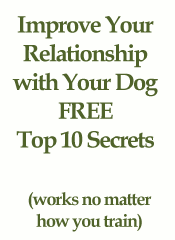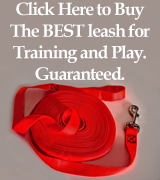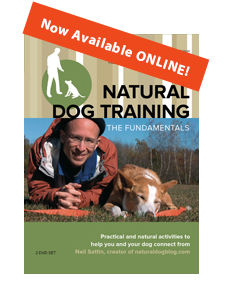This situation might seem familiar to you: You're on a walk with your dog, through the woods, around the neighborhood, wherever. Everything is fine, doggie is just sniffing the ground, and you're feeling nice and relaxed, just enjoying the scenery. All of a sudden, your dog's ears prick up, and BOOM! - they're off after a squirrel (or insert other distraction here - could be another dog, a cat, a person, a skateboarder, etc.). Your dog is straining at the end of the leash (they are on a leash, right?), nearly pulling you off your feet to get at that thing. Maybe your dog is eager? Maybe your dog is showing signs of aggression? In either case, what do you do to redirect that energy into something positive? In this article, I'm going to show you how you can use the Natural Dog Training technique of pushing (or tug-of-war, if you haven't gotten to "pushing" yet) to relax and redirect an excited or aggressive dog, so that all of their energy is directed where it belongs - at you!
So, back to our example. You're there with your dog, and your dog is pulling at the end of their lead. How did you get to this point? If you remember our discussion about how our dogs emotionally respond to the world, you may recall that our dogs are constantly receiving sensory input from their environment, to which they're always responding. As your dog gets more energized, the natural way for them to resolve that energy is to find a prey object - to satisfy their prey instinct. Since humans tend to be more "predator" and less prey-like, an energized dog is automatically in a state of conflict with their owner. The human wants their dog to stick around and pay attention to them, while the dog wants to release some of this mojo on that there squirrel! The squirrel (or other dog, or whatever has got your dog's attention) is the path of least resistance for the energy revving up inside of them, so that's where it's inclined to go.
What YOU need to do in this situation is allow your dog to resolve that energy, the energy that's whirring around within them and wanting to make contact with the world. In simple terms, here's what's happening now:
- You're on a walk with your dog and your dog gets distracted by a squirrel, another dog, etc. "Getting distracted" means that they feel energy whirring inside of them, and they think that interacting with the squirrel-dog-etc. is the only way for them to resolve that feeling.
- Your dog is straining on the leash to try to get at that squirrel, which it can't do.
- You're frustrated because you want your dog to pay attention to you in this situation.
- Because your dog doesn't experience any satisfaction, they are also frustrated and have even MORE energy stored up for the next time they see a squirrel, another dog, etc.
Trust me, I know how this feels. In my earlier life (pre-Natural Dog Training), it seemed that every time Nola sensed another animal's presence she was off - and no amount of calling her would stop her. No treat was more enticing than that squirrel-dog-whatever. She caught a squirrel once, which I'm sure only fueled her desire to catch more. Any time I tried to "correct" her, that only seemed to increase her drive (more on this phenomenon in an upcoming article). Natural Dog Training did offer me a solution, which I'm about to share with you.
Side note - are you one of those people whose dog chases squirrels and who tells people "oh, Sparky wouldn't know what to do if he/she actually caught one"? I can tell you, from experience, that your dog will know EXACTLY what to do when they catch the squirrel - and it ain't pretty, nor does it feel good watching the squirrel breathe its last breath. So do yourself a favor and start redirecting that prey drive back to you, where it belongs.
OK - back on track. Remember our article on pushing, which is the Natural Dog Training way of getting your dog's prey-drive directed at you? Please read it and practice it. You want to be at the point where in an undistracted situation you can call your dog's name, and your dog will eagerly push against you for the food that you have in your hand. At a minimum (if you haven't tried pushing yet) - you should read my article on how to play tug of war with your dog, and if your dog is eager to play tug you can substitute tug-of-war for pushing...temporarily. Ultimately you want to use pushing, as it is a fundamental Natural Dog Training technique that we will revisit again and again (and you are reading the NaturalDogBlog, after all) - and it will give you the BEST way to satisfy 100% of your dog's prey drive.
Here is what your walk will look like now, with the redirection worked into it:
- You're on a walk and your dog gets distracted by a squirrel, another dog, etc.
- You remain impassive, holding the leash, letting your dog strain on the lead in their effort to get at whatever's distracting them. Get your food (if you're pushing) or your tug toy (if you're playing tug-of-war) ready.
- You are waiting for your opportunity, which looks like this: Your dog will get frustrated with not being able to get to whatever is distracting them. That energy in them demands a more immediate resolution, and there will be a moment when suddenly their focus will waver, and your dog will look for something else to satisfy that energy. The signs of a break in focus could be something as obvious as them looking in other directions for something else on which to fixate, or a cease in their barking, or it could be as subtle as a change in ear position from cocked forward (at the distraction) to ears-cocked-to-the-side (searching for something else worth fixating on). This is your chance!
- At the moment when you notice your dog's attention wavering, you should call their name with a mix of excitement and authority in the tone of your voice. That instant is your chance to penetrate their awareness, which up until that moment has been entirely fixed on the squirrel/dog/etc. Start moving backwards, away from them, enticing them to follow you. If you're pushing, this is the time when you push with your dog. If you're playing tug-of-war, wiggle the tug toy, let them bite it, pull a bit, and let them win.
- At this point, if you have their attention enough for another round of pushing (or tug-of-war - you'll need the 2nd tug toy or a treat to exchange with them for the initial tug toy in order to play again right away) - then by all means, do it!
- Walk in a different direction. You don't have to walk in the opposite direction, just walk so that you're not heading back towards the distraction. Remain animated - if you can, get your dog to chase you past the distracting area, reward your dog with praise and treats, and then continue your walk.
Whereas before you had no way to satisfy your dog's prey drive in these moments, now you will be inserting yourself into the cycle in a way that is VERY fulfilling for your dog. As you'll recall, whenever you had these encounters before, both of you ended up frustrated. This time around you will be having a successful encounter with the distracting forces of the world, which looks something like this:
- You're on a walk. Your dog sees a squirrel-dog-etc. and feels energy whirring inside of them, and they think that interacting with that squirrel-dog-etc. is the way to resolve that energy.
- Dog strains at leash. You stand still, impassive, prepared and waiting. When your dog looks for another outlet to satisfy their prey drive, you are right there with pushing/tug-of-war to satisfy it for them.
- Walk continues, with your dog's prey drive satisfied, and with your need to have influence in these situations satisfied as well.
After this simpler, more satisfying cycle gets repeated over and over with your dog, something interesting will happen. When your dog sees the thing that formerly distracted them, they will immediately look to YOU to resolve the energy that gets going inside of them. You are teaching your dog that when they feel "that feeling" (of energy stirring inside of them), that INTERACTING WITH YOU is the way to resolve that feeling. Interacting with you is what it "feels" like to "get that squirrel-dog-etc." At that point, interacting with you has become the path of least resistance. Not that your dog will "think" like this per se, but they might wonder what the point is of all that straining on the lead that they WERE doing, when ultimately the way to satisfaction is by pushing/playing tug with you. The pattern will develop into something like this:
- You're on a walk with your dog. Your dog sees a squirrel-dog-etc.
- Your dog looks to you immediately. You seize the moment and push with your dog/play tug-of-war. Both of you are satisfied.
In this article we have talked about how we can become the resolution to our dog's desire to make prey in energizing situations. I encourage you to remember in these moments to breathe, relax, and focus on simply paying attention to what your dog is experiencing. Wait patiently for the moment that their concentration shifts, and make sure that you're prepared to captivate their prey drive when it does. Through using the techniques of pushing and playing tug-of-war, you'll be able to teach your dog that YOU can resolve the energy that the world sends their way, and your dog will become even more attracted to you in these high energy moments.
As always, thanks for stopping by, and if you have any questions, feel free to leave them for me in the comments - or you can e-mail me directly: neil at naturaldogblog dot com.





I just stumbled upon your site - I have 3 dogs and one is dog aggressive - I will be trying out your technique for sure asap... My question is what advice do you have for walking 3 dogs? I imagine your answer will be to work with the aggressive dog individually, before trying to walk all 3 of them together - but any advice is welcome! 🙂
Hi Elizabeth,
You got it! You have to establish a new pattern of behavior with your aggressive dog, and then be able to work with your dog in context (i.e. your dog is getting all tense around another dog, and you rechannel that aggression into play with you, etc.) - before you'll be able to do that with your other dogs in tow. There's pretty much no way around it, unless you want to put yourself or your other dogs at risk.
But you'll definitely feel it to be worth it when as you see progress. Thanks so much for your question.